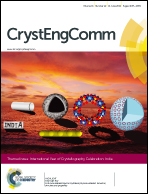Passive optical waveguiding tubular pharmaceutical solids and Raman spectroscopy/mapping of nano-/micro-scale defects†
Abstract
Self-assembled one dimensional pharmaceutical solids composed of caffeine, carbamazepine and glibenclamide drugs exhibit optical waveguiding tendency due to the efficient two dimensional lateral optical confinement effect. Additionally, the confined optical waves within the tubes were used to probe the nano-/micro-scale defect sites inherited during the tube self-assembly process via Raman spectroscopy.

- This article is part of the themed collection: International Year of Crystallography Celebration: India

 Please wait while we load your content...
Please wait while we load your content...